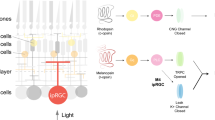Summary
Tiger salamanders (Ambystoma tigrinum) trained as larvae to orient in a particular compass direction reverse their direction of movement approximately at metamorphosis, but the timing of reversal is not closely related to developmental stage. Although exogenous thyroxine facilitates metamorphosis, it does not simultaneously trigger reversal of movement (Fig. 1). The reversal occurs even if the animals are deprived of a continuous view of the sky. Administration of pulses of exogenous melatonin at noon, but not serotonin or thyroxine, caused the larvae to shift their directional response about 90° clockwise (Figs. 2, 3). This result is consistent with the view that melatonin pulses mimic “lights-on” and act to phase-delay the animal's endogenous timekeeping mechanism.
Similar content being viewed by others
References
Adler, K.: Extraoptic phase shifting of circadian locomotor rhythm in salamanders. Science164, 1290–1292 (1969)
Adler, K.: Extraocular photoreception in amphibians. Photochem. Photobiol.23, 275–298 (1976)
Adler, K., Taylor, D.H.: Extraocular perception of polarized light by orienting salamanders. J. Comp. Physiol.87, 203–212 (1973)
Andrews, R.V.: Temporal secretory responses of cultured hamster adrenals. Comp. Biochem. Physiol.26, 179–193 (1968)
Batschelet, E.: Statistical methods for the analysis of problems in animal orientation and certain biological rhythms. Washington: Am. Inst. Biol. Sci. 1965
Batschelet, E.: Recent statistical methods for orientation data. In: Animal orientation and navigation. Galler, S.R., Schmidt-Koenig, K., Jacobs, G.J., Belleville, R.E. (eds.), pp. 61–91. Washington: Natl. Aeronaut. Space Admin. (publ. 262) 1972
Binkley, S.: Pineal gland biorhythms:N-acetyltransferase in chickens and rats. Fed. Proc.35, 2347–2352 (1976)
Binkley, S., MacBride, S.E., Klein, D.C., Ralph, C.: Pineal enzymes: regulation of avian melatonin synthesis. Science181, 273–275 (1974)
Binkley, S., MacBride, S.E., Klein, D.C., Ralph, C.: Regulation of pineal rhythms in chickens: refractory period and nonvisual light perception. Endocrinology96, 848–853 (1975)
Corrent, G., McAdoo, D.J., Eskin, A.: Serotonin shifts the phase of the circadian rhythm from theAplysia eye. Science202, 977–979 (1978)
Demian, J.J., Taylor, D.H.: Photoreception and locomotor rhythm entrainment by the pineal body of the newt,Notophthalmus viridescens (Amphibia, Urodela, Salamandridae). J. Herpetol.11, 131–139 (1977)
Duvall, D., Norris, D.O.: Stimulation of terrestrial-substrate preferences and locomotor activity in newly transformed tiger salamanders (Ambystoma tigrinum) by exogenous or endogenous thyroxine. Anim. Behav. (in press) (1979)
Frye, B.E.: Hormonal control in vertebrates, 122 pp. London: Macmillan Co. 1967
Gern, W.A., Norris, D.O.: Plasma melatonin in the neotenic tiger salamander (Ambystoma tigrinum): effects of photoperiod and pinealectomy. Gen. Comp. Endocrinol. (in press) (1979)
Gwinner, E., Benzinger, I.: Synchronization of a circadian rhythm in pinealectomized European starlings by daily injections of melatonin. J. Comp. Physiol.127, 209–213 (1978)
Klein, D.C., Weller, J.: Indole metabolism in the pineal gland: a circadian rhythm inN-acetyltransferase. Science169, 1093–1095 (1970)
Kollros, J.J.: Mechanisms of amphibian metamorphosis: hormones. Am. Zool.1, 107–114 (1961)
McKeown, J.P.: The ontogenic development of Y-axis orientation in four species of anurans. Doctoral dissertation, Mississippi State University iv, 48 pp. (1968)
Norris, D.O.: Hormonal and environmental factors involved in the determination of neoteny in urodeles. In: Comparative endocrinology. Gaillard, P.J., Boer, H.H. (eds.), pp. 109–112. Amsterdam: Elsevier/North-Holland, Biomedical 1978
Phillips, J.B.: Use of the earth's magnetic field by orienting cave salamanders (Eurycea lucifuga). J. Comp. Physiol.121, 273–288 (1977)
Phillips, J.B., Adler, K.: Directional and discriminatory responses of salamanders to weak magnetic fields. In: Animal migration, navigation, and homing. Schmidt-Koenig, K., Keeton, W.T. (eds.), pp. 325–333. Berlin, Heidelberg, New York: Springer 1978
Quay, W.B.: Retinal and pineal hydroxyindole-O-methyl transferase activity in vertebrates. Life Sci.4, 983–991 (1965)
Ralph, C., Pelham, R.W., MacBride, S.E., Reilly, C.P.: Persistent rhythms of pineal and serum melatonin in cockerels in continuous darkness. J. Endocrinol.63, 319–324 (1974)
Taylor, D.H.: Extra-optic photoreception and compass orientation in larval and adult salamanders (Ambystoma tigrinum). Anim. Behav.20, 233–236 (1972)
Taylor, D.H., Adler, K.: The pineal body: site of extraocular perception of celestial cues for orientation in the tiger salamander (Ambystoma tigrinum). J. Comp. Physiol.124, 357–361 (1978)
Tomson, O.H.: Celestial orientation in larvae and juveniles of four species ofAmbystoma. Doctoral dissertation, Mississippi State Univ. vi, 41 pp. (1974)
Tomson, O.H., Ferguson, D.E.: Y-axis orientation in larvae and juveniles of three species ofAmbystoma. Herpetologica28, 6–9 (1972)
Turek, F.W., McMillan, J.P., Menaker, M.: Melatonin: effects on the circadian locomotor rhythm of sparrows. Science194, 1441–1443 (1976)
Veerdonk, F.C.G. van de: Demonstration of melatonin in Amphibia. Curr. Mod. Biol.1, 175–177 (1967)
Author information
Authors and Affiliations
Additional information
Supported by NSF grant BNS 75-18693 to K. Adler and a postdoctoral fellowship (NSF GU-2058) and grant (NSF GB-41102) to D.H. Taylor. We thank Sue Binkley and John B. Phillips for constructive comments on the manuscript, and David O. Norris for manuscripts of papers in press.
Rights and permissions
About this article
Cite this article
Adler, K., Taylor, D.H. Melatonin and thyroxine: Influence on compass orientation in salamanders. J. Comp. Physiol. 136, 235–241 (1980). https://doi.org/10.1007/BF00657538
Accepted:
Issue Date:
DOI: https://doi.org/10.1007/BF00657538




